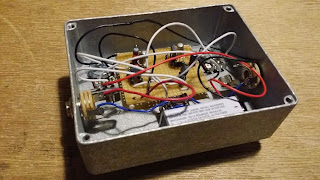This is the story of a 1 knob, 1 switch treble/bass booster with mid cut.
The challenge, instant EQ change for a boost (or cut) to move the guitar into another sonic room. I started with a known (and often used) boost schematic, the LPB-1. This is a very easy (easy's good) 1 transistor transparent boost. Minimal parts, very tweakable. The EHX Mole/Hog's Foot bass boost and Screaming Bird/Tree treble boost are variants of this circuit with larger or smaller caps to achieve the desired frequency response.
In my prototype I used both the Mole and Screaming Bird input capacitors and made them switchable for an either or arrangement. The Mole has additional .1uf capacitors from the collector to v+ and emitter to ground. I allowed control of these with a stacked B100k potentiometer. I split the difference on the output cap and went with .1uf. The output cap does not have as much impact on the sound and works fine in both bass and treble modes.
I added Nocentelli's mid scoop control to the output. It does knock down the output volume quite a bit. I added another gain stage to compensate when the scoop is enabled.
 |
| Swiss Cheese Prototype |
After experimenting with and listening to the prototype and receiving feedback from friends I decided to limit the amount of control-ability to one knob and one switch. The knob would sweep between bass and treble boost. The switch would enable the mid scoop. There would be internal trimmers for output volume and amount of scoop.
 |
| Version 1.1 |
 |
| All Boxed Up |
This thing sounds remarkably good with bass for a big helping of extra boom. On the treble side at adds shimmer to clean tones and has a Rangemaster effect to already dirty sounds. The mid scoop is troubling before a dirty signal. The overall effect is added messiness and more pronounced low end, not in a pretty way. Clean however, with the input cap balance skewed toward the treble end and the mid scoop engaged, a Fender guitar has delicious shimmer and bite at some very tasty, ear pleasing frequencies.
There is still work to do but it is going the right direction.









